Pinal County, Arizona facts for kids
Quick facts for kids
Pinal County
|
||
|---|---|---|
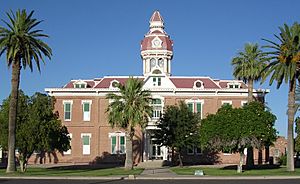
Second Pinal County Courthouse in Florence
|
||
|
||
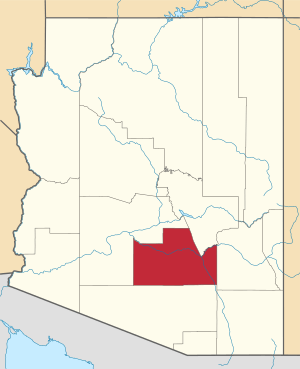
Location within the U.S. state of Arizona
|
||
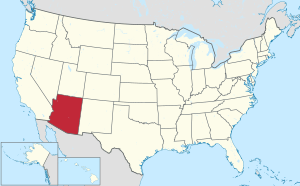 Arizona's location within the U.S. |
||
| Country | ||
| State | ||
| Founded | February 1, 1875 | |
| Named for | Pinal Peak | |
| Seat | Florence | |
| Largest municipality | San Tan Valley Maricopa (incorporated) |
|
| Area | ||
| • Total | 5,374 sq mi (13,920 km2) | |
| • Land | 5,366 sq mi (13,900 km2) | |
| • Water | 8.6 sq mi (22 km2) 0.2% | |
| Population
(2020)
|
||
| • Total | 425,264 | |
| • Estimate
(2023)
|
484,239 |
|
| • Density | 79.134/sq mi (30.5537/km2) | |
| Time zone | UTC−7 (Mountain) | |
| Congressional districts | 2nd, 5th, 6th, 7th | |
Pinal County is a county located in the middle of Arizona, a state in the United States. In 2020, about 425,264 people lived here. This makes it the third most populated county in Arizona. The main city, or county seat, where the county government is located, is Florence. Pinal County was officially started in 1875.
Pinal County includes parts of several Native American lands. These are the Tohono Oʼodham Nation, the Gila River Indian Community, and the San Carlos Apache Indian Reservation. It also fully includes the Ak-Chin Indian Community.
Pinal County is part of the larger Phoenix metropolitan area. This means it's connected to big cities like Phoenix, Mesa, and Chandler. Many people are moving into the northern parts of the county from Phoenix. Also, people are moving into the southern parts from Tucson. Pinal County has five main cities: Maricopa, Casa Grande, Apache Junction, Eloy, and Coolidge. There are also many smaller areas that are not officially cities or towns, called unincorporated areas. These areas have been growing quickly.
Contents
History of Pinal County
Pinal County was created on February 1, 1875. It was formed from parts of two nearby counties: Maricopa County and Pima County. The name "Pinal" is believed to come from the Pinal Mountains, which are covered in pine trees.
Between 2000 and 2010, Pinal County was one of the fastest-growing counties in the entire U.S. In 2010, CNN Money even said it was the second fastest-growing county. Looking ahead, Pinal County might face challenges from very hot weather and wildfires. These changes could affect the environment and the local economy.
Geography of Pinal County
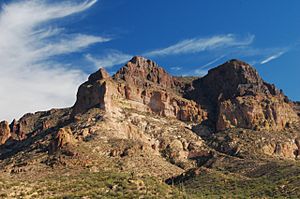
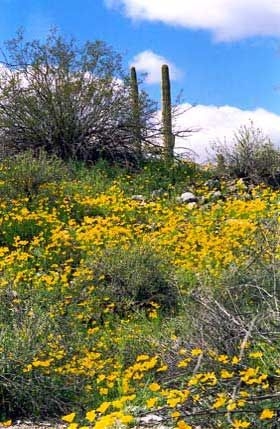
Pinal County covers a total area of about 5,374 square miles. Most of this area, about 5,366 square miles, is land. Only a small part, about 8.6 square miles, is water.
Mountain Ranges in Pinal County
Pinal County is home to several mountain ranges. These include:
Counties Next to Pinal County
Pinal County shares borders with several other counties:
- Maricopa County – to the west and north
- Gila County – to the north
- Graham County – to the east
- Pima County – to the south
Main Highways in Pinal County
 Interstate 8
Interstate 8 Interstate 10
Interstate 10 U.S. Route 60
U.S. Route 60 Historic U.S. Route 80
Historic U.S. Route 80 State Route 24
State Route 24 State Route 77
State Route 77 State Route 79
State Route 79 State Route 84
State Route 84 State Route 87
State Route 87 State Route 177
State Route 177 State Route 187
State Route 187 State Route 238
State Route 238 State Route 287
State Route 287 State Route 347
State Route 347 State Route 387
State Route 387 State Route 587
State Route 587
Protected Natural Areas
Pinal County has several important natural areas that are protected. These include:
- Casa Grande Ruins National Monument
- Coronado National Forest (part)
- Hohokam Pima National Monument
- Ironwood Forest National Monument (part)
- Sonoran Desert National Monument (part)
- Tonto National Forest (part)
Population Information
| Historical population | |||
|---|---|---|---|
| Census | Pop. | %± | |
| 1880 | 3,044 | — | |
| 1890 | 4,251 | 39.7% | |
| 1900 | 7,779 | 83.0% | |
| 1910 | 9,045 | 16.3% | |
| 1920 | 16,130 | 78.3% | |
| 1930 | 22,081 | 36.9% | |
| 1940 | 28,841 | 30.6% | |
| 1950 | 43,191 | 49.8% | |
| 1960 | 62,673 | 45.1% | |
| 1970 | 67,916 | 8.4% | |
| 1980 | 90,918 | 33.9% | |
| 1990 | 116,379 | 28.0% | |
| 2000 | 179,727 | 54.4% | |
| 2010 | 375,770 | 109.1% | |
| 2020 | 425,264 | 13.2% | |
| 2023 (est.) | 484,239 | 28.9% | |
| U.S. Decennial Census 1790–1960 1900–1990 1990–2000 2010–2020 |
|||
2010 Census Details
In 2010, the census showed that 375,770 people lived in Pinal County. There were about 125,590 households, which are groups of people living together. About 92,157 of these were families.
Most people in the county, about 72.4%, were white. About 5.6% were American Indian, and 4.6% were black or African American. People of Hispanic or Latino background made up 28.5% of the population.
In terms of family life, 37.0% of households had children under 18 living with them. About 55.8% were married couples. The average household had 2.78 people. The average age of people in the county was 35.3 years old. The typical income for a household was around $51,310 per year.
Communities in Pinal County
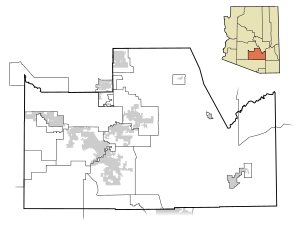
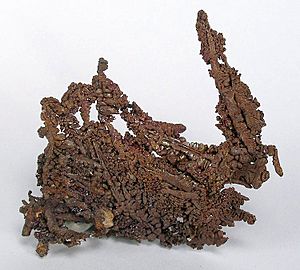
Cities in Pinal County
- Apache Junction (partially in Maricopa County)
- Casa Grande
- Coolidge
- Eloy
- Maricopa
Towns in Pinal County
- Florence (this is the county seat)
- Hayden (partially in Gila County)
- Kearny
- Mammoth
- Marana (mostly in Pima County)
- Queen Creek (partially in Maricopa County)
- Superior
- Winkelman (partially in Gila County)
Census-Designated Places (CDPs)
These are areas that are like towns but are not officially incorporated.
- Ak-Chin Village
- Arizona City
- Blackwater
- Cactus Forest
- Campo Bonito
- Casa Blanca
- Catalina (partially in Pima County)
- Chuichu
- Dudleyville
- Gold Canyon
- Goodyear Village
- Kohatk
- Lower Santan Village
- Oracle
- Picacho
- Queen Valley
- Red Rock
- Sacate Village
- Sacaton
- Sacaton Flats Village
- Saddlebrooke
- San Manuel
- Santa Cruz
- San Tan Valley
- Stanfield
- Stotonic Village
- Sweet Water Village
- Tat Momoli
- Top-of-the-World (partially in Gila County)
- Upper Santan Village
- Vaiva Vo
- Wet Camp Village
Other Unincorporated Communities
These are smaller communities that are not officially cities, towns, or CDPs.
- Arizola
- Bapchule
- Barkerville
- Burns
- Kelvin
- Oracle Junction
- Randolph
- Ray Junction
- Reymert
- Riverside
- Santan
Ghost Towns
These are towns that used to exist but are now abandoned.
Population Ranking of Communities
This table shows the population of cities, towns, and CDPs in Pinal County based on the 2020 census. † county seat
| Rank | City/Town/etc. | Population (2020 Census) | Municipal type | Incorporated |
|---|---|---|---|---|
| 1 | San Tan Valley | 99,894 | CDP | |
| 2 | Queen Creek (Mostly in Maricopa County) | 59,519 | Town | 1990 |
| 3 | Maricopa | 58,125 | City | 2003 |
| 4 | Casa Grande | 53,658 | City | 1879 (founded) |
| 5 | Marana (mostly in Pima County) | 51,908 | Town | 1977 |
| 6 | Apache Junction (partially in Maricopa County) | 38,499 | City | 1978 |
| 7 | † Florence | 26,785 | Town | 1900 |
| 8 | Eloy | 15,635 | City | 1949 |
| 9 | Coolidge | 13,218 | City | 1945 |
| 10 | Saddlebrooke | 12,574 | CDP | |
| 11 | Gold Canyon | 11,404 | CDP | |
| 12 | Arizona City | 9,868 | CDP | |
| 13 | San Manuel | 3,692 | CDP | |
| 14 | Oracle | 3,656 | CDP | |
| 15 | Superior | 3,319 | Town | 1976 |
| 16 | Kearny | 2,261 | Town | 1959 |
| 17 | Sacaton | 1,824 | CDP | |
| 18 | Mammoth | 1,759 | Town | 1958 |
| 19 | Dudleyville | 1,068 | CDP | |
| 20 | Casa Blanca | 1,004 | CDP | |
| 21 | Queen Valley | 566 | CDP | |
| 22 | Stanfield | 515 | CDP |
See also
 In Spanish: Condado de Pinal para niños
In Spanish: Condado de Pinal para niños


